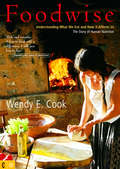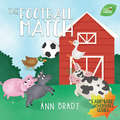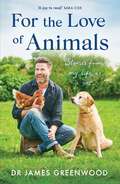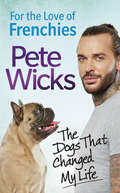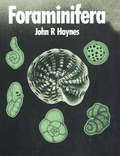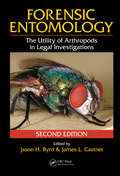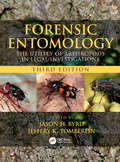- Table View
- List View
Food Quality and Consumer Value: Delivering Food that Satisfies
by Monika J.A. SchröderConsumer markets for foods and beverages in developed countries are well supplied and highly fragmented. Yet, the question being asked is how close retailers actually come to fulfilling their customers' requirements. The concept of consumer value is one of the main pillars underpinning the theory of market differentiation. This book takes an interdisciplinary approach to the analysis of satisfaction in relation to the consumption of food, with both food science and consumer science playing central parts. It approaches food quality from both the technical and the consumer satisfaction perspectives, and assesses the roles of management and regulatory tools in delivering food quality for all. Each area is discussed in detail, using the appropriate technical terminology, but keeping the text accessible to readers from both academic traditions, as well as to non-specialist readers.
Food, Science and Society: Exploring the Gap Between Expert Advice and Individual Behaviour (Gesunde Ernährung Healthy Nutrition)
by P. S. Belton T. Belton T. Beta D. Burke L. Frewer A. Murcott J. Reilly G. M. SeddonThere is widespread concern amongst consumers about the safety and acceptability of food, and there are clearly communication gaps between consumers, many food professionals and food industry. This book offers accounts of the two-way nature of this difficult communication process and steps that can be made to bridge these communication gaps in a variety of social and cultural environments. Individual chapters of the book analyze the roles of science, culture, and risk perception, and of mass media and attitudes towards eating. An additional section describes the interface between scientists and lay people with regard to policy-making and agricultural practice.
Foodwise: Understanding What We Eat and How it Affects Us, the Story of Human Nutrition
by Wendy E. CookWendy Cook’s fascination with nutrition began during her war-time childhood. In the midst of deprivation and food-rationing, the rich abundance of her mother’s organic garden made a profound impression. In her twenties, married to Peter Cook, she discovered the artistic and magical effects that food could have in creating a convivial atmosphere. During this period she cooked for many well-known names, including John Lennon, Paul McCartney, Dudley Moore, Peter Ustinov and Alan Bennett. But it was only later, through her daughter falling ill, that she came to study and understand deeper aspects of nutrition, and in particular the effects of different foods on human health and consciousness.In Foodwise Wendy Cook presents a remarkable cornucopia of challenging ideas, advice and commentary, informed by the seminal work of the scientist Rudolf Steiner. She begins the volume with biographical glimpses relating to her experience of food and how it has influenced her life. She then presents an extraordinary perspective on the journey of human evolution, relating it to changes in consciousness and the consumption of different foods. In the following section she considers the importance of agricultural methods, the nature of the human being, the significance of grasses and grains, the mystery of human digestion, and the question of vegetarianism. In the next section she analyses the ‘building blocks’ of nutrition, looking in some detail at the nutritional (or otherwise) qualities of many foodstuffs, including carbohydrates, minerals, fats and oils, milk and dairy products, herbs and spices, salt and sweeteners, stimulants, legumes, the nightshade family, bread, water, and dietary supplements. She ends with practical tips on cooking, planning menus, children’s food, sharing meals, and some mouth-watering recipes.Foodwise presents a treasure of wisdom and experience for anybody with a concern for the content of the food they eat or a desire to discover more about the physical, soul and spiritual aspects of nutrition.
Foot and Mouth Disease: Current Perspectives
by Francisco Sobrino and Esteban DomingoThe shock following the recent outbreak of foot-and-mouth disease (FMD) in the UK dispelled the notion that this disease was permanently under control and could be forgotten. FMD proved to be an endemic disease in many countries and continues to pose a major threat to animal health worldwide. The development of more effective and socially acceptabl
Foot and Mouth Disease: Current Perspectives
by Francisco Sobrino Esteban DomingoThe shock following the recent outbreak of foot-and-mouth disease (FMD) in the UK dispelled the notion that this disease was permanently under control and could be forgotten. FMD proved to be an endemic disease in many countries and continues to pose a major threat to animal health worldwide. The development of more effective and socially acceptabl
The Football Match (Little Friends: Farmyard Adventures Series #6)
by Ann BradyThe farmer and his family have gone out for the day so the Little Friends are having a football match. Rover Dog is one of the referees and Hilary Horse and Betty Cow are the team captains. Find out which team Penny Pig, Georgie Goat, the chickens and ducks are on, and what their team names are. Which team will win the game?
Footprints: In Search Of Future Fossils
by David FarrierA profound meditation on climate change and the Anthropocene and an urgent search for the fossils—industrial, chemical, geological—that humans are leaving behind
Footprints in the Woods: The Secret Life of Forest and Riverbank
by Sir John Lister-KayeLONGLISTED FOR THE HIGHLAND BOOK PRIZESHORTLISTED FOR THE RICHARD JEFFERIES AWARDA WATERSTONES BEST BOOK OF 2023Footprints in the Woods is John Lister-Kaye's charming account of a year spent with otters, badgers, weasels and pine martens. This family - Mustelidae - all live in the wild at Aigas, the conservation and field study centre in the Highlands that he calls home.With fifty years of experience living side-by-side with these creatures and the patience of a true naturalist, John reveals the lives of these elusive animals: sometimes red in tooth and claw, but often playful, familial, curious and surprising.
For Better or For Worse? Collaborative Couples in the Sciences (Science Networks. Historical Studies #44)
by Annette Lykknes, Donald L. Opitz and Brigitte Van TiggelenIn this volume, a distinguished set of international scholars examine the nature of collaboration between life partners in the sciences, with particular attention to the ways in which personal and professional dynamics can foster or inhibit scientific practice. Breaking from traditional gender analyses which focus on divisions of labor and the assignment of credit, the studies scrutinize collaboration as a variable process between partners living in the nineteenth and twentieth centuries who were married and divorced, heterosexual and homosexual, aristocratic and working-class and politically right and left. The contributors analyze cases shaped by their particular geographical locations, ranging from retreat settings like the English countryside and Woods Hole, Massachusetts, to university laboratories and urban centers in Berlin, Stockholm, Geneva and London. The volume demonstrates how the terms and meanings of collaboration, variably shaped by disciplinary imperatives, cultural mores, and the agency of the collaborators themselves, illuminate critical intellectual and institutional developments in the modern sciences.
For the Love of Animals: Stories from my life as a vet
by Dr James Greenwood'A joy to read' - SARA COXGrowing up in Yorkshire and with farming blood in his genes, James Greenwood always knew he would end up as a vet.Animals have been part of James' life for as long as he can remember, from pulling lambs on a hilltop farm as a child and having stick insects crawling out of his school uniform in class, to renting a flat behind a zoo in Jersey and finding himself treating a newborn baby elephant as a newly qualified vet. Written with his trademark warmth and humour, James offers a fascinating insight into the world of veterinary medicine with tales of treating cats and dogs, horses, pigs and cows, as well as delving deep into his relationship with his beloved and much-missed, one-eyed Labrador, Oliver.However, the path to realising his childhood ambition has not always been easy and at times he has questioned whether it truly is the best job in the world. Through all of the challenging lows and extraordinary highs, it has been the animals themselves that have spurred James on to want to continue vetting and helping him find his calling as a GP vet. Warm, poignant and full of heart, James' story is both a beautiful tribute to the role animals play in our lives and a rare glimpse into what it's really like to be a vet, and is perfect for fans of Matt Baker, The Yorkshire Shepherdess and The Supervet.
For the Love of Bob
by James BowenFrom best friends James Bowen and street cat Bob, stars of the number one bestselling A Street Cat Named Bob, comes a special edition of The World According to Bob for children aged 11 and above.Best friends James Bowen and street cat Bob have been on a remarkable journey together. In the years since their story ended in BOB: NO ORDINARY CAT James, with Bob's help, has begun to find his way in the world.Along with the adventures and the fun there have been tough times too, but through moments of real danger and sometimes illness Bob has always been there as James' protector and guardian angel.FOR THE LOVE OF BOB is the is the incredible story of James and Bob's life-saving friendship, and the lessons James has learnt from his street-wise cat.
For the Love of Cats
by Kate MayThey’re intelligent, inquisitive, regal and daft, and with their soulful eyes and velvety paws, it’s no wonder that cats are one of our most beloved animals. Packed with fascinating facts, heart-warming stories and inspiring quotes, For the Love of Cats is perfect for anyone who knows the incomparable joy of a purring feline companion.
For the Love of Dogs
by Kate MayThere is no love like that between a dog and its owner. Packed with fascinating facts and trivia, heart-warming stories and inspiring quotes, For the Love of Dogs is perfect for anyone who values the trusty companionship of their favourite hound.
For the Love of Frenchies: The Dogs that Changed my Life
by Pete WicksThe only way is a rescue dog.French Bulldogs are the UK’s most popular dog breed, and nobody loves them more than Pete Wicks. Although he’s most famous for his appearances on The Only Way is Essex, he’s never happier than when he’s with his best friend – no, not James Lock – his French Bulldog Eric. But their story hasn’t been all walkies and biscuits. In 2016, Pete was devastated to suddenly lose his adored French Bulldog Ernest at just three years old. The Wolfpack was torn apart. Left to pick up the pieces with Eric, he realised that he knew very little about the breed and the reason why Ern died so young. In honour of his old pal, Pete teamed up with animal charities and uncovered the shocking unregulated breeding and illegal importation that led to the life-threatening illness Ernest suffered from. And the problem is widespread. But if you want one of the best companion dogs you could ever own, a pup that is affectionate and playful (or some would say mischievous), then a French Bulldog is perfect for you. Here Pete reveals the many tips he’s learned for a happy life with a Frenchie, and how we can all help to eradicate the problems facing the breed. Most touchingly, for the first time he bravely recounts that love and grief we all feel for a special dog. This is a book that EVERY dog lover needs to read.
For the quite very actual love of Worzel
by Catherine PicklesWorzel is still an enormous Lurcher with 'issues,' but his issues are now predictable. Now in his fourth year with his forever family, life is changing. As the children grow up and begin to spread their wings, Worzel's world should be more peaceful. But as life rolls on, a changing of the guard brings new challenges; challenges no-one seems ready to embrace, least of all the cats.An over-enthusiastic encounter with a fish pond, a blackbird with a death wish, and a new arrival all conspire to ensure that whilst Worzel might be ready for an easy life, his family has other plans.Mum, long-suffering Dad, five cats and two grown-up children all feature in Worzel's fourth diary, bringing together poems, letters and advice that Worzel's beginning to wonder if it's even worth offering any more.The eagerly-awaited fourth instalment from Worzel, the literary Lurcher is funny, touching, honest, and very real.
Foraging Behavior
by A. C. Kamil J. R. Drebs H. R. PulliamForaging behavior has always been a central concern of ecology. Understanding what animals eat is clearly an essential component of under standing many ecological issues including energy flow, competition and adaptation. Theoretical and empirical developments in the late 1960's and 1970's led to a new emphasis in the study of foraging behavior, the study of individual animals in both field and laboratory. This development, in turn, led to an explosion of interest in foraging. Part of the reason for this explosion is that when foraging is studied at the individual level, it is relevant to many disciplines. Behaviorists, including ethologists and psychologists, are interested in any attempt to understand behavior. Ecologists know that a better understanding of foraging will contribute to resolving a number of important ecological issues. Anthropologists and others are applying the ideas coming out of the study of foraging behavior to problems within their disciplines. These developments led to a multidisciplinary symposium on foraging behavior, held as part of the 1978 Animal Behavior Society meetings in Seattle, Washington. Many ecologists, ethologists and psychologists participated or attended. The symposium was very successful. generating a high level of excitement. As a result, the participants decided to publish the proceedings of the symposium (Kami1 & Sargent 1981).
Forebrain Atlas of the Short-tailed Fruit Bat, Carollia perspicillata: Prepared by the Methods of Nissl and NeuN Immunohistochemistry
by Frank Scalia John J Rasweiler IV Jason Scalia Rena Orman Mark StewartThe Forebrain Atlas of the Short-tailed Fruit Bat, Carollia perpicillata, is unique among brain atlases. Not only is this the first quality atlas treatment of a bat species, but the atlas is also unique in its use of NeuN staining. Carollia perpicillata, a tropical species, is the only bat that has essentially been domesticated and can be maintained and propagated in a research environment utilizing simple, inexpensive husbandry procedures. The NeuN preparations used in this atlas selectively stain neurons in a sharp black coloration that fills not only the cell body but extends a short distance along the proximal dendrites. Thus, as distinct from the traditional nissl stains, which generate a shade of blue largely restricted to the cell body, the NeuN generates a quasi Golgi-like image of the neurons. This provides a more intimate view of the neurons than can be obtained from nissl staining. In addition, the background is essentially white, facilitating high-contrast photography and allowing for gray-tone illustration without any loss of information. The NeuN procedure does not stain axons, and since it does not stain glial cells or their nuclei, the noise ordinarily generated in nissl stains by the presence of glial cells among the neurons and in the white matter is entirely eliminated. The Forebrain Atlas of the Short-tailed Fruit Bat also includes nissl stained sections for two reasons: One, since some readers may be unfamiliar with the NeuN images, it is useful to include familiar images for comparison. More importantly, it is known that NeuN is not expressed in certain neurons, such as Purkinje cells, olfactory bulb mitral cells, and the cells of the paraventricular and supraoptic nuclei. The nissl stained sections are thus included to provide complementary views of such structures. The atlas will be useful for students and investigators doing neuroscience research on bat and other mammalian species, as well as students of comparative biology, zoology, brain evolution, and the history of neuroanatomical analysis.
Forensic Entomology: International Dimensions and Frontiers (Contemporary Topics in Entomology)
by M. Eric Benbow Jeffery Keith TomberlinThe use of forensic entomology has become established as a global science. Recent efforts in the field bridge multiple disciplines including, but not limited to, microbiology, chemistry, genetics, and systematics as well as ecology and evolution. The first book of its kind, Forensic Entomology: International Dimensions and Frontiers provides an inc
Forensic Entomology: International Dimensions and Frontiers (Contemporary Topics in Entomology)
by M. Eric Benbow Jeffery Keith TomberlinThe use of forensic entomology has become established as a global science. Recent efforts in the field bridge multiple disciplines including, but not limited to, microbiology, chemistry, genetics, and systematics as well as ecology and evolution. The first book of its kind, Forensic Entomology: International Dimensions and Frontiers provides an inc
Forensic Entomology: The Utility of Arthropods in Legal Investigations, Second Edition
by Jason H. Byrd James L. CastnerThe first edition of Forensic Entomology: The Utility of Arthropods in Legal Investigations broke ground on all levels, from the caliber of information provided to the inclusion of copious color photographs. With over 100 additional color photographs, an expanded reference appendix, and updated information, the second edition has raised the bar for resources in this field, elucidating the basics on insects of forensic importance. New in the Second Edition: A chapter on insect identification that presents dichotomous keys Updates on DNA molecular techniques and genetic markers Coverage of new standardization in forensic entomological analysis Chapters on climatology and thermoregulation in insects 100 new color photographs, making available a total of 650 color photographs Goes Beyond Dramatics to the Nitty Gritty of Real Practice While many books, movies, and television shows have made forensic entomology popular, this book makes it real. Going beyond dramatics to the nitty gritty of actual practice, it covers what to search for when recovering entomological evidence, how to handle items found at the crime scene, and how to use entomological knowledge in legal investigations.
Forensic Entomology: The Utility of Arthropods in Legal Investigations, Third Edition
by Jason H. Byrd Jeffery K. TomberlinForensic Entomology: The Utility of Arthropods in Legal Investigations, Third Edition continues in the tradition of the two best-selling prior editions and maintains its status as the single-most comprehensive book on Forensic Entomology currently available. It includes current, in-the-field best practices contributed by top professionals in the field who have advanced it through research and fieldwork over the last several decades. The use of entomology in crime scene and forensic investigations has never been more prevalent or useful given the work that can be done with entomological evidence. The book recounts briefly the many documented historical applications of forensic entomology over several thousand years. Chapters examine the biological foundations of insect biology and scientific underpinnings of forensic entomology, the principles that govern utilizing insects in legal and criminal investigations. The field today is diverse, both in topics studied, researched and practiced, as is the field of professionals that has expanded throughout the world to become a vital forensic sub-discipline. Forensic Entomology, Third Edition celebrates this diversity by including several new chapters by premier experts in the field that covers such emerging topics as wildlife forensic entomology, microbiomes, urban forensic entomology, and larval insect identification, many of which are covered in depth for the first time. The book will be an invaluable reference for investigators, legal professionals, researchers, practicing and aspiring forensic entomologists, and for the many students enrolled in forensic science and entomology university programs.
Forensic Entomology: The Utility of Arthropods in Legal Investigations, Third Edition
by Jason H. Byrd; Jeffery K. TomberlinForensic Entomology: The Utility of Arthropods in Legal Investigations, Third Edition continues in the tradition of the two best-selling prior editions and maintains its status as the single-most comprehensive book on Forensic Entomology currently available. It includes current, in-the-field best practices contributed by top professionals in the field who have advanced it through research and fieldwork over the last several decades. The use of entomology in crime scene and forensic investigations has never been more prevalent or useful given the work that can be done with entomological evidence. The book recounts briefly the many documented historical applications of forensic entomology over several thousand years. Chapters examine the biological foundations of insect biology and scientific underpinnings of forensic entomology, the principles that govern utilizing insects in legal and criminal investigations. The field today is diverse, both in topics studied, researched and practiced, as is the field of professionals that has expanded throughout the world to become a vital forensic sub-discipline. Forensic Entomology, Third Edition celebrates this diversity by including several new chapters by premier experts in the field that covers such emerging topics as wildlife forensic entomology, microbiomes, urban forensic entomology, and larval insect identification, many of which are covered in depth for the first time. The book will be an invaluable reference for investigators, legal professionals, researchers, practicing and aspiring forensic entomologists, and for the many students enrolled in forensic science and entomology university programs.
Forensic Entomology: International Dimensions and Frontiers
by Jeffery Keith Tomberlin M. Eric BenbowThe use of forensic entomology has become established as a global science. Recent efforts in the field bridge multiple disciplines including, but not limited to, microbiology, chemistry, genetics, and systematics as well as ecology and evolution. The first book of its kind, Forensic Entomology: International Dimensions and Frontiers provides an inc
Forensic Science in Wildlife Investigations
by Adrian LinacreThe range of species that fall within the realm of wildlife crimes is extensive, ranging from ferns and orchids to bald eagles and great whales. Solving these crimes is rarely dependent on the testimony of witnesses or victims. An ever-increasing number of research groups are applying scientific tests to animal and plant studies alike. However, unt


